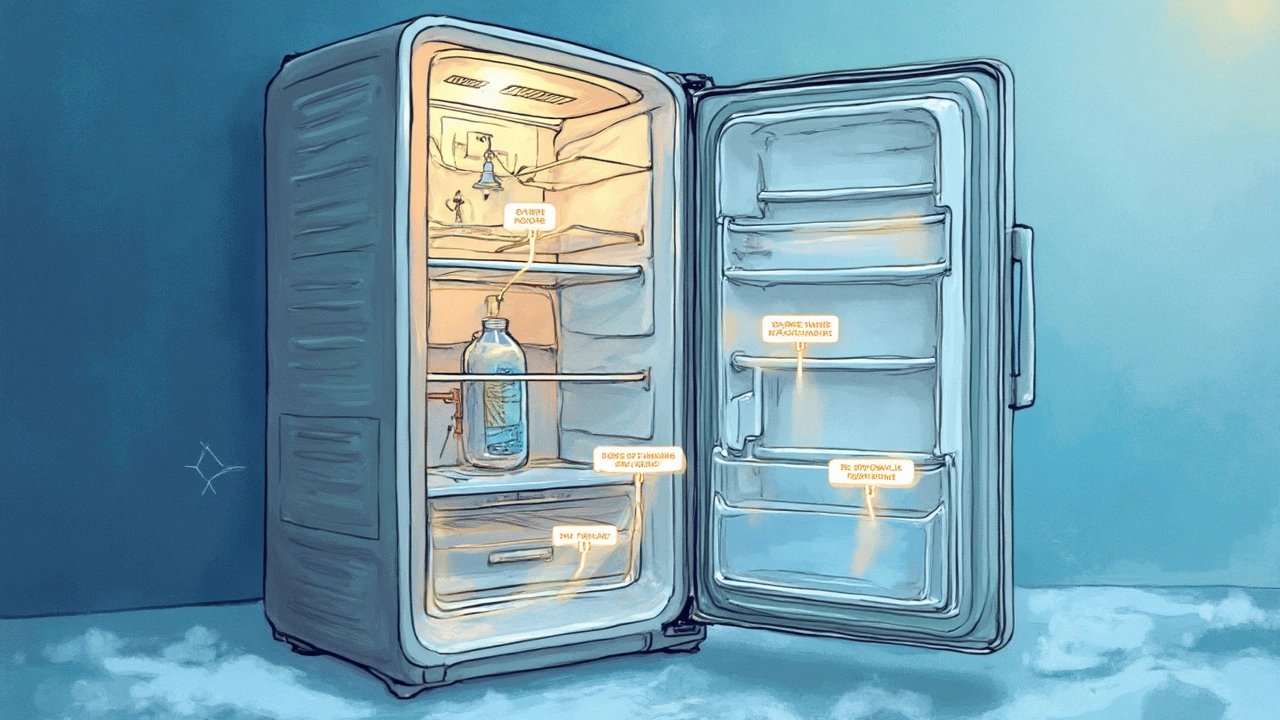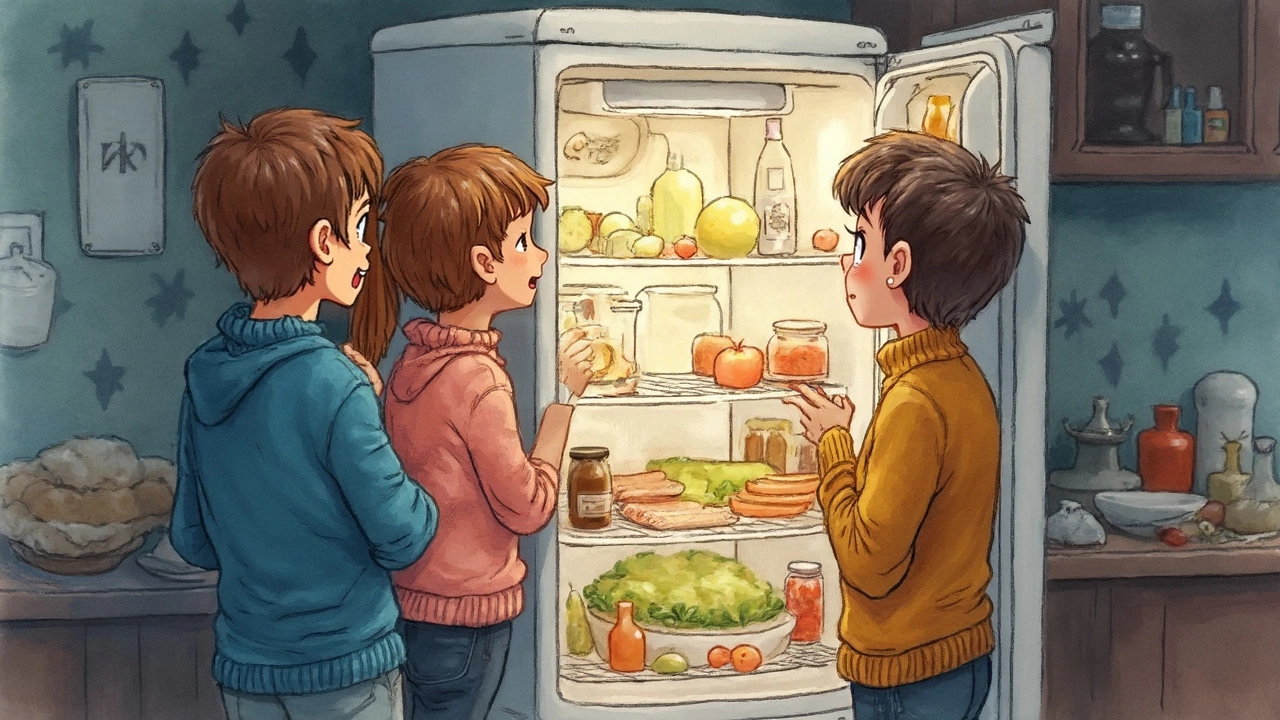So, your fridge isn't keeping things cold, but when you open the door, the light's shining bright. Annoying, right? Weirdly enough, that light could be the one thing working perfectly while the cooling system itself is struggling. Let's break down what's going on and how you might fix it.
First off, there are a few common reasons that your fridge might lose its chilly powers. Sometimes it's as simple as the thermostat getting bumped or misadjusted. Before diving into more complicated issues, make sure the thermostat's set to the right temperature.
If you've set the thermostat properly and it's still not working, the vents could be blocked. Keeping your fridge overstuffed or rearranging things without keeping an air path can lead to trouble. Have a peek inside and make sure nothing's blocking the vents—a quick fix if that's the issue!
- Common Causes for Cooling Issues
- Checking the Thermostat
- Inspecting the Vents
- Compressor Troubles
- Maintenance Tips
- When to Call a Professional
Common Causes for Cooling Issues
So, your fridge is powered on, but it's acting more like a lukewarm cupboard than the icy hub it should be. What's going wrong? There are a few typical suspects behind cooling issues. Let's get into those.
First, consider the power supply and the settings. While it sounds basic, double-check that your fridge is actually plugged in properly and that nothing messed with the settings. Kids, pets, or an accidental bump might have changed them.
Next up, the thermostat. It might be faulty. If you're adjusting it and nothing's happening, this could be why your fridge feels more like room temp. A quick way to check is to listen for any sound changes when you adjust it—silence could mean trouble.
How about the coils? Dirty or dusty condenser coils can cause all sorts of cooling headaches. The solution? Regular cleanup. You’d be surprised how a little dust can mess things up.
There's also the issue of blocked vents. If your fridge is stuffed with goodies, it can obstruct airflow. Air needs to circulate around all your food to keep everything cool. Check that nothing's blocking those vital vents.
- Power supply: Ensure it's plugged in and settings are correct.
- Thermostat: A non-responsive thermostat might need a closer look.
- Condenser coils: They require regular cleaning to function efficiently.
- Vent blockage: Make sure nothing's in the way of internal air circulation.
Address these factors, and you'll be on your way to bringing that fridge back to its chilly best. If not, it might be time to suspect deeper issues like compressor problems, but let's tackle that later.
Checking the Thermostat
Alright, let's get into thermostat business. Think of the thermostat as the brain of the fridge. It's what tells the cooling system when to kick in. If your fridge isn't cooling but the light is on, it's a good idea to see if the thermostat is causing the hiccup.
First, take a look at the thermostat setting. The perfect temperature should be around 37°F (3°C) for the fridge and 0°F (-18°C) for the freezer. If it's cranked too low or too high, that might be messing with the cooling.
- Double-check the dial or digital setting. Make sure nobody has accidentally changed it, especially if you've got kids around.
- Listen for a clicking noise when you adjust the thermostat. If you don't hear one, there might be an issue.
- If you have a newer model with an electronic panel, reboot the system by unplugging it for a minute—like turning it off and on again!
Got no luck fixing it? Pop open the fridge and give the thermostat sensor a quick inspection. It's the little probe sticking out of the control board. If it's loose or covered in grime, wipe it down and secure it.
Now, if you've tried all this and your fridge is still not cooling, you might have a faulty thermostat. In this case, replacing it isn't usually a DIY task unless you're pretty handy with gadgets. This might be the point where you call in a pro.
Remember, keeping your fridge at the right temperature isn't just about saving your food from spoilage. It's also about making sure your appliance runs smoothly and efficiently, saving you money on those pesky electric bills.
Inspecting the Vents
Alright, let’s talk about something that often flies under the radar but can totally mess up your fridge's cooling—the vents. These little openings are crucial for making sure cold air circulates inside your refrigerator. If they’re blocked, your fridge might feel more like a sad, underpowered fan than a cool haven for your snacks.
First thing’s first, have a glance at the back and sides of your fridge compartments. That’s where most of these vents are hiding. If they’re covered up by a frozen pizza or a big carton of milk, there’s your problem. Move stuff away and see if that helps get the cold air flowing again.
It’s also a good idea to make sure those vents aren’t clogged with any gunk or frost. Speaking of frost, if you see a lot of ice, it might point to a defrost issue, which also needs checking out. Here’s a tiny checklist to guide you through:
- Locate the vents—usually on the back wall or sides.
- Ensure there's space around them for air to pass through.
- Remove any items that may be blocking the vents.
- Check for and clear any frost or dirt buildup.
If after clearing the vents, your refrigerator isn’t cooling down, it might be time to look at other issues like the compressor or even call in a pro. But hey, tackling the vents is a simple first step that can often solve the problem right then and there.

Compressor Troubles
If your fridge won't cool but the light's still on, you might be dealing with some compressor troubles. This mighty component acts like the heart of your refrigerator, playing a crucial role in the cooling cycle.
Think of the compressor as a pump that circulates refrigerant throughout the cooling system. If it's not working right, your fridge won't get cold no matter what. One dead giveaway is if the fridge feels warm to touch outside or if you hear weird rattling noises. These are big, red flags.
The compressor could face issues due to overheating or faulty start relays. A bad start relay can stop the compressor from turning on. Listen for clicking noises—this often means the relay is trying to start the compressor and failing.
"A faulty compressor can turn your fridge into just an expensive storage cabinet," says Mark Tindle, a known appliance repair expert from Cool Technics Inc.
If you suspect compressor problems, you've got a couple of steps to troubleshoot:
- Unplug your refrigerator and give it some rest—sometimes it's just overheated.
- Check any unusual sounds or vibrations when you plug it back in.
- Inspect the coils at the back of the fridge for dust or blockages, as these can cause overheating.
If these tips don't help, it might be time to bring in a professional to repair the compressor. Replacing or fixing it yourself isn't advisable unless you're a trained technician. Remember, keeping your fridge in top shape could save you money on groceries and energy bills!
Let's face it, dealing with a broken compressor can be a real hassle. According to a Consumer Reports survey in 2023, about 42% of fridge repairs are due to compressor issues. If you're facing one, you're certainly not alone.
Maintenance Tips
Keeping your fridge running smoothly doesn't have to be a huge chore. A little bit of regular maintenance can go a long way in preventing problems down the road, especially issues like cooling issues. Here are some handy tips to keep your fridge in top-notch condition:
- Clean Those Coils: The coils at the back or bottom of your fridge can get really dusty. Dusty coils mean the fridge has to work harder, which could lead to it not cooling well. Grab a vacuum or a coil brush every few months to clean them off.
- Check Door Seals: The door seals keep the cold in, so if they're cracked or loose, your fridge won't cool properly. Close the door on a piece of paper halfway and try pulling it out. If it slips out easily, the seal might need replacing.
- Keep It Level: Believe it or not, your fridge needs to be level for the doors to shut correctly and for the compressor to work right. Use a level tool to make sure everything's even, and adjust the feet if necessary.
- Temperature Check: Make sure you're setting the temperature just right. Ideally, your fridge should be at around 37°F (3°C) and the freezer at 0°F (-18°C). Keeping them too cold can make the compressor work overtime.
- Declutter and Organize: Crowded shelves block vents and stop the cooling from circulating. Make sure there's space for air to flow by not overloading your fridge.
Just by taking these small steps, you can help avoid breakdowns and extend the life of your fridge. It’s way nicer to do a quick clean-up every so often than deal with a full-on repair. Trust me, your fridge will thank you for it!
When to Call a Professional
Alright, so you've tinkered with the basics, tweaked a few settings, and double-checked the obvious culprits but your fridge is still not cooling. It might be time to bring in a professional. Here's when you should definitely consider it.
First, if the compressor is making loud noises or not running at all, it's beyond a simple DIY fix. The compressor is like the heart of your fridge's cooling system, and dealing with it requires specific skills and tools. In fact, messing with it without proper knowledge can sometimes void your warranty.
Another red flag is if the refrigerator's back or bottom feels excessively hot. While some warmth is normal, increased heat can indicate more serious problems like failing fans or malfunctioning components that only a pro can accurately diagnose and repair.
If you've noticed leaking or strange smells, this could mean a refrigerant leak. Refrigerants are not something you want to handle yourself due to environmental and safety regulations.
| Indicator | When to Call a Professional |
|---|---|
| Compressor Issues | Loud or silent compressor |
| Excessive Heat | Back or bottom feels very hot |
| Leaks or Odors | Puddles or strange smells |
Finally, if you've ruled out simple fixes and the fridge is fairly new, check for warranty coverage. Many manufacturers offer warranties or service plans that could cover the repairs for little to no cost out of pocket. So don't stress—handing the reins over to a reliable expert might save more time and hassle in the long run.
